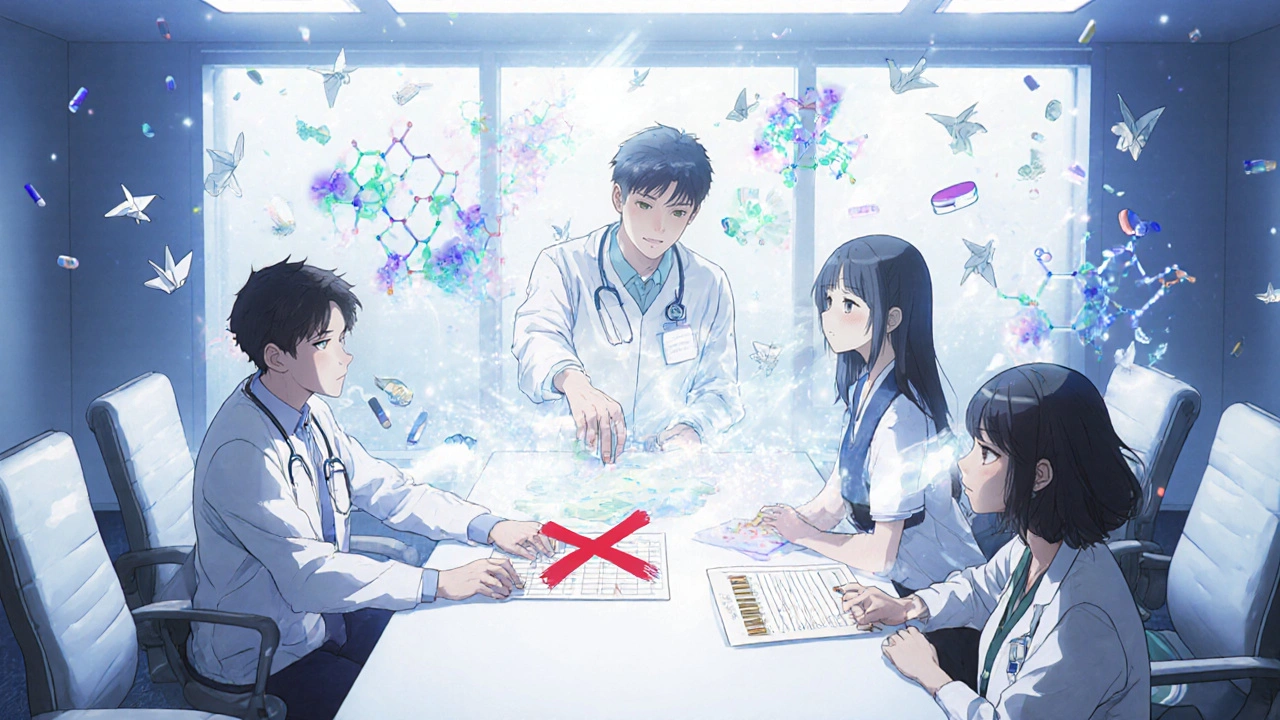When a doctor prescribes a medication and the pharmacist gives a different one, patients often assume it’s just a cheaper generic. But sometimes, it’s something more complex - and more intentional. That’s therapeutic interchange. And it’s not about swapping drugs from different classes. It’s about swapping within the same class - using a different drug that works just as well, but costs less. This isn’t random. It’s a carefully planned move, made by teams of pharmacists and doctors, backed by evidence, and built into hospital and long-term care formularies.
What Therapeutic Interchange Actually Means
Therapeutic interchange means replacing one drug with another from the same therapeutic class. For example, switching from lisinopril to losartan - both are ACE inhibitors or ARBs used for high blood pressure. Or changing from atorvastatin to rosuvastatin, both statins for cholesterol. These aren’t generics. They’re different chemical compounds, but they do the same job. The goal? Keep the patient safe and effective, while cutting costs.
This isn’t a pharmacist’s decision alone. It’s not like picking a store-brand painkiller off the shelf. It’s a formal process. Hospitals and skilled nursing facilities have Pharmacy and Therapeutics (P&T) Committees - teams of doctors, pharmacists, nurses, and sometimes patients - who review data and decide which drugs make the approved list. If a drug on that list is cheaper and just as effective, the pharmacist can swap it without calling the doctor, as long as it’s on the pre-approved list.
Contrast that with generic substitution. That’s when you get the same drug, just cheaper - like switching from brand-name Lipitor to generic atorvastatin. Therapeutic interchange is different. You’re changing the drug itself, but staying in the same class. And it’s not allowed across classes. You don’t swap a beta-blocker for a calcium channel blocker unless there’s a clinical reason - and that’s not therapeutic interchange. That’s a new prescription.
Why Providers Use It
Drug prices keep climbing. In 2018, U.S. drug costs rose 8% - and they’ve kept going up. For hospitals and long-term care facilities, medication budgets are under constant pressure. A single nursing home with 100 residents might spend $50,000 a month on drugs. Swap just a few high-cost medications for lower-cost alternatives in the same class, and you save tens of thousands.
But cost isn’t the only reason. Some drugs in the same class have fewer side effects. One statin might cause muscle pain in some patients, while another doesn’t. One blood pressure drug might be easier to take once a day. Therapeutic interchange lets providers tailor treatment without starting from scratch. It’s about improving adherence and outcomes, not just cutting costs.
Studies show this works. More than 80% of U.S. hospitals had formal therapeutic interchange programs by 2002. Today, it’s even more common. In skilled nursing facilities, where residents often take 10 or more medications, these programs save money without hurting care. One facility reported saving $35,000 a month just by switching three commonly prescribed drugs to lower-cost alternatives within the same class.

How It Works in Practice
It doesn’t happen by accident. Here’s how it usually goes:
- A P&T Committee reviews clinical data, cost, and safety profiles of drugs in a class.
- They pick one or two as preferred options - the ones with the best balance of effectiveness, safety, and price.
- They create a written policy: which drugs can be swapped, who can approve it, and when exceptions apply.
- Pharmacists check the prescription against the formulary. If it’s a non-preferred drug, they substitute the preferred one.
- They document the change and notify the prescriber - sometimes with a letter signed by the doctor ahead of time.
In long-term care, many facilities use “TI letters” - pre-signed authorizations from doctors that allow pharmacists to make swaps automatically. Once signed, the pharmacy can switch to the preferred drug every time that original drug is ordered. No phone calls. No delays. Just smoother care.
But in community pharmacies? It’s much harder. Most states require pharmacists to contact the prescriber before making any swap - even if it’s within the same class. That slows things down. It’s why therapeutic interchange is mostly an institutional tool, not a retail one.
Where It Fails
Therapeutic interchange isn’t magic. It only works when the drugs are truly comparable. Swapping a drug that’s slightly less effective, or one with more side effects, can hurt patients. That’s why evidence matters. The American College of Clinical Pharmacy says the substitution must be “likely to have a substantially equivalent therapeutic effect.”
Some patients are sensitive to small differences. One person might do great on metoprolol but have bad reactions to atenolol - even though both are beta-blockers. That’s why exceptions are built into every policy. If a patient has already responded well to a non-preferred drug, or has a history of intolerance, the swap doesn’t happen.
Another problem? Prescriber resistance. Some doctors don’t like being bypassed, even if the change is safe. They want to be in control. That’s why communication is key. Successful programs include regular feedback loops - pharmacists alert doctors to changes, and doctors can opt out if needed.
And state laws vary. In some states, pharmacists have broad authority to make swaps. In others, every change needs a new prescription. That inconsistency makes it harder for national chains and multi-state facilities to standardize practices.

What Patients Should Know
If you get a different pill than expected, don’t panic. Ask: “Is this the same kind of medicine?” If it is - same class, same purpose - and your doctor or pharmacist says it’s safe, it’s probably a therapeutic interchange. You’re not getting a worse drug. You’re getting an equally good one that costs less.
But you should still speak up. Tell your pharmacist or doctor if you’ve had bad reactions to any drug in that class before. If you’re on a tight budget, ask if there’s a lower-cost option in the same class. You’re not just a patient - you’re part of the team.
And if you’re confused? Ask for a copy of the formulary policy. Most hospitals and nursing homes will give it to you. It’s your right to know why your medication changed.
The Future of Therapeutic Interchange
As drug prices keep rising, therapeutic interchange will keep growing - especially in long-term care and hospitals. But the focus is shifting. It’s not just about cost anymore. It’s about personalization. Newer formularies are getting smarter, using patient data to predict which drug in a class will work best for whom.
Some places are even starting to include patient preferences in decisions. If someone says, “I hate taking pills at night,” and there are two drugs in the same class - one taken at night, one in the morning - they’ll pick the morning one. It’s still therapeutic interchange. But now it’s also patient-centered.
What won’t change? The rule: no swapping across classes. That’s not therapeutic interchange. That’s a different treatment plan. And that needs a new prescription - and a new conversation.
Therapeutic interchange is a quiet revolution in healthcare. It’s not flashy. It doesn’t make headlines. But it saves money, reduces side effects, and keeps patients on the right meds - all without asking them to pay more or see their doctor more often.


Anne Nylander
November 21, 2025 AT 03:22OMG this is such a game changer!! I had no idea pharmacists could do this without calling the doc every time. My grandma’s meds got switched last month and she’s way more stable now-no more dizziness! Seriously, why isn’t everyone talking about this??
Franck Emma
November 22, 2025 AT 07:40This is why healthcare is broken.
Noah Fitzsimmons
November 23, 2025 AT 02:54Oh wow, so now pharmacists are playing doctor? Let me guess-the ‘P&T Committee’ is just a bunch of bean counters in lab coats who’ve never met a patient. You think swapping lisinopril for losartan is ‘evidence-based’? Try telling that to the guy whose cough turned into a full-time job because of ARBs. This isn’t innovation. It’s negligence with a PowerPoint.
Eliza Oakes
November 24, 2025 AT 21:42Oh please. You all act like this is some revolutionary breakthrough. I’ve been getting my blood pressure med swapped since 2012. And guess what? My doctor didn’t even tell me until I noticed the pill color changed. This isn’t ‘patient-centered’-it’s corporate cost-cutting dressed up like a TED Talk. Also, ‘TI letters’? Sounds like a cult initiation.
Clifford Temple
November 25, 2025 AT 21:28Let me get this straight-Americans are letting pharmacists swap life-saving meds because we can’t afford to pay for them? That’s not healthcare, that’s surrender. We should be forcing Big Pharma to lower prices, not letting pharmacy techs play roulette with our prescriptions. This is what happens when you let bureaucrats run medicine. #MakeMedicineGreatAgain
Corra Hathaway
November 26, 2025 AT 23:53YASSSSS this is literally why I love pharmacists 😭 They’re the real MVPs behind the scenes! I used to stress every time my med changed, but now I know it’s not a mistake-it’s a SMART move. And hey, if it saves money AND keeps me feeling good? Win-win! 🙌 Also, if you’re scared, just ASK. No shame in asking questions. We got this! 💪❤️
Shawn Sakura
November 27, 2025 AT 08:38While it is indeed a commendable and clinically sound practice, one must not overlook the procedural rigor required to ensure therapeutic equivalence, particularly with regard to pharmacokinetic and pharmacodynamic profiles across heterogeneous patient populations. That said, the institutional adoption of standardized formularies, supported by evidence-based guidelines and documented prescriber authorization protocols, represents a paradigmatic shift toward value-driven care delivery. That being said, typos happen. I meant to say ‘paradigmatic’ not ‘paradimatic.’
Swati Jain
November 27, 2025 AT 19:35As a clinical pharmacist in Mumbai, I’ve seen this work wonders in resource-limited settings. But here’s the kicker: in the U.S., you’ve got formularies that are basically corporate procurement documents masquerading as clinical guidelines. We swap drugs based on formulary tier, not patient phenotype. You call it ‘personalization’? It’s algorithmic austerity with a smiley face. And yes, I’ve seen patients on rosuvastatin develop rhabdo while the cheaper atorvastatin was fine-because the P&T committee didn’t account for CYP3A4 polymorphisms in South Asians. Data matters. Not just cost.